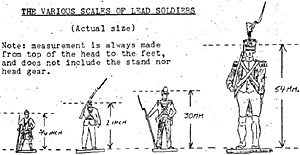Being a commercial maker of war game figures, to me the first and most important step for the beginner is choosing the soldiers he will use for his war game This choice means automatically that he also chooses the period of history he wishes to fight his games in.
The man who likes tanks, bazookas, and machine guns will wish for modern soldiers, which means he will be fighting modern battles. Those that like armored knights will choose the ancient or medieval historical periods. Thus, the choice of the soldiers you wish to use is of primary importance to the beginner.
War games can be divided into three categories with many variations therein. There is the Ancient War Game, the Musket Period War Game, and the Modern War Game. Within the musket period, for example, one has a wide choice of the American Revolution, Fredrick the Great, the Napoleonic era, the American Civil War, and many others.
As a rule, most war game generals attempt to be as realistic about their play as historically possible. Since the musket, for example, was a short range and inaccurate weapon, the rules for musket period warfare will take this into account. Ancient war games would feature more melees and less missile fire. Modern war games would feature more fire power and less hand-to-hand action. Tactics, strategy, and troop formations are thus always kept within realistic, historical bounds wherever possible.
Therefore, in choosing Your troops for your war game armies, you should pick a force representing the period of history you like the best, and in which you may have some research in military history, tactics, and uniform information.
Once this decision is reached, the next question is the choice of the size of the lead soldiers you wish to use. This choice will automatically determine what scale your war game will be fought in. Scale means the size a lead soldier represents as compared to a man, and is almost as important to the war game general as to the model railroad hobbyist, whose passion for scale is well known.
 Today, the beginner has a choice of several different scales in lead soldiers. There is the
so called standard 54mm (2 1/8 inch) soldier, the 30mm (1 inch), and some of the fantastic and
beautiful figures made by Greenwood and Ball of England (and produced by me here in the USA) that stand only 1/2 and 1 inch high.
Today, the beginner has a choice of several different scales in lead soldiers. There is the
so called standard 54mm (2 1/8 inch) soldier, the 30mm (1 inch), and some of the fantastic and
beautiful figures made by Greenwood and Ball of England (and produced by me here in the USA) that stand only 1/2 and 1 inch high.
The scale of the soldier you desire also depends on the space you have available to fight war games in. The floor of a large room is ample for a large number of 54mm figures, while a kitchen table is adequate for the 3/4 inch Greenwood and Ball soldiers. The 54mm figure at one time was perhaps the most popular war game piece, but today, with the advent on the market of the 30mm and smaller soldiers, you'll find these predominate in most experienced general's shelves.
I should mention here also that many players use the "flat" silhouette type soldier for war games. Viewed from the side, these look well. They are fairly inexpensive, easy to store, and a tremendous variety is available on the market. However, I'm very biased for "round," three dimensional soldiers, as I cannot quite get used to the sight of a horde of enemy troops coming at me, and all I can see is a thin edge of an indistinguishable figure!
In the round figures, the 54mm Britains soldiers are obtainable from Bob Bard, Box 1463, Baltimore 3, NED. The 30mm figures are somewhat harder to find. Only two companies produce these that I know of, myself and the S.A.E. firm. The S.A.E. figures are painted and quite inexpensive, and there is' a wide variety to choose from - if you can find a dealer somewhere that handles them. Sometimes these figures are available in tov stores, but few miniature dealers in the U.S. handle them. And letters direct to the S.A.E. people (who operate in South Africa) are generally ignored,
I have recently entered the war game field with a wide selection of 30mm figures, and the Greenwood and Ball miniatures in 1/2 and 1 inch sizes.
More All About Wargames
- Chapter 1: Introduction
Chapter 2: Troops
Chapter 3: Converting and Painting
Chapter 4: Wargame Set Up
Chapter 5: Army Organization
Chapter 6: Basic Rules
Chapter 7: Campaigns
Back to MWAN #106 Table of Contents
Back to MWAN List of Issues
Back to MagWeb Magazine List
© Copyright 2000 Hal Thinglum
This article appears in MagWeb (Magazine Web) on the Internet World Wide Web.
Other military history articles and gaming articles are available at http://www.magweb.com